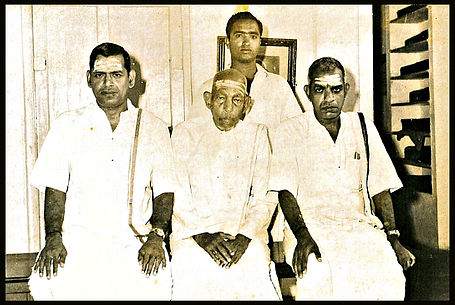
Purnaprajna
Bangere
Guru's gurus
H. K. Narasimhamurthy (HKN) had intensive training under Parur Sundaram Iyer and his two illustrious sons M. S. Anantharaman and M. S. Gopalakrishnan.
Parur Sundaram Iyer
PARUR SUNDARAM Iyer was born in 1891. Trivandrum Ramaswamy Bhagavather, Asthana Vidwan of Travancore Palace, initiated him into violin. He was then sent to Mumbai to study under Pandit Vishnu Digambar Paluskar, principal, Gandharva Maha Vidhyalaya. Upon hearing the young Sundaram Iyer, Paluskar appointed Sundaram Iyer as professor of violin and also taught him Hindustani Music. In 1909, Sundaram Iyer introduced violin in Hindustani Music for the first time. In 1916, he was awarded a gold medal and a Certificate of Proficiency. In 1922, he proceeded to Chennai. He was a Faculty Member of the University of Madras in the Music Department.
Most importantly for violinists, Parur Sundaram Iyer developed a new way of playing the instrument, which usually goes under the name Parur style. Actually it is much more than a style, it is a system, and should be called Parur system, much like the Galamian system for the western classical violin. Parur system approaches violin techniques from bottom up. Production of a pure and clean tone is emphasized; this is usually associated to bowing techniques of various kinds. Next comes the complex scales and precise fingering on how to play them in three octaves. This system develops techniques to play scales in different ways. For example, through pure gamaka approach (that is by complex slides to express the microtones) or using at least 3 different bowing techniques. The main idea behind all this is to facilitate musical expression unhindered by technical difficulties. After the practice of scales, comes the approach to Varnams (musical compositions known for their technical difficulties and which are played usually as first items in concerts.) Parur system employs a unique approach for playing the varnams. One of things that make it different is the use of single string to play the entire varnam. The idea is to give a markedly lilting and lyrical form to the exposition that is unblemished by bow changing the strings. The practice regimen also involves practicing the varnams from different position of the scale (this is similar to key change.)
Parur Sundaram Iyer's genius created a new paradigm; it was a radically new approach to violin playing and musical interpretation. This started a new epoch in Indian music, and is now pursued by many musicians all over. The greatest exponent of the Parur system and beyond is of course his son, the peerless M. S. Gopalakrishnan. He will be dealt with in a separate page. For these contributions and much more, we humbly thank Parur Sundaram Iyer. Parur Sundaram Iyer was a terrific teacher and produced many students. My guru HKN is one of the greatest teachers' in that lineage.
M. S. Anantharaman
He is the senior most guru of the school now. He was born in 1924 in Chennai. His father Parur Sundaram Iyer initiated him into music early. He started his musical career at age 7. There would be a stream of musicians to Sundaram Iyer's house. Anantharaman’s interaction with them gave him a firm grounding in the grammar of music and manodharma. His progress was swift, and he has established himself in the front rank among musicians. A broadly educated man, he specialized in mathematics at Pachaiyappa’s College and secured a diploma in German from Max Mueller Bhavan. His fluency in English literature is visible for anyone who brings these topics up. He fluently quotes from Milton’s ‘Paradise Lost’ to Shakepeare!
The violin virtuoso has performed with many major musicians of the South and Omkarnath Thakur and Pt. Vinayak Rao Patwardhan of the North. MSA has toured throughout the world.
He is a brilliant pedagogue of the violin, patient and insightful, he guides his students with deep affection. My teacher HKN credits him for many things he learnt from MSA down the years. His magnificent violinist sons M. A. Sundaresan and M. A. Krishnaswamy, two of the leading violinists of their generation, epitomize how effective MSA has been as a teacher.
The senior most guru of our school is known for his innate humility, kindness and generosity towards all and in particular the younger generation of musicians. It is with deep pleasure and fondness I recollect my own meetings with the great master, my guru's guru.
-Purnaprajna Bangere
Kansas City, March 2015

MSA, MSG and HKN with Parur Sundaram Iyer, late 1960's, at MSG's home in Mylapore, Chennai.

MSA, MSG with Yehudi Menuhin, circa 1951, Chennai, India.